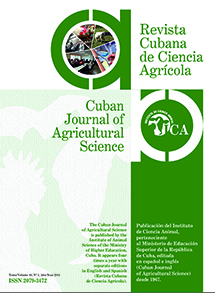Economic evaluation of productive and reproductive indicators in dairy cows with different ages at first calving, in grazing systems
Contenido principal del artículo
Resumen
In livestock activity, profitability can be evaluated by calculating zootechnical indices, because of their relation with production and, consequently, to the main income source for the farmer. The aim of this study was to evaluate the importance of a group of productive-reproductive indicators, not always valued, in the economic results of milk production in system based on grazing. Retrospective data was used, corresponding to lactations of 1,785 primiparous Holstein cows, American-Canadian biotype, collected between 1999-2016 in two establishments located in Entre Ríos
province, Argentina. Fifty members from each of the following three age groups at first calving were randomly chosen: Group 1: 750 days (24 months), Group 2: 840 days (27 months) and Group 3: 1,098 days (32 months). Group characterization was based on values of the following indicators: total productive life, total milk production, milk index, productive days, number of calvings, production per lactation and mean calving interval. Significant differences between groups (p<0.05) were only
observed for total productive life. Although all three groups produced similar amounts of milk, cows in the late calving age group resulted in higher incomes. It is concluded that indicators calving interval, efficiency in rearing, age at first calving and longevity, all of which are easy to register, acquire relevance when evaluating their impact while modeling the final economic result of the establishment, thus enabling the technical and managerial decision making, aimed to improve system profitability.
Key Words: dairy cows, age at first calving, calving interval, longevity
province, Argentina. Fifty members from each of the following three age groups at first calving were randomly chosen: Group 1: 750 days (24 months), Group 2: 840 days (27 months) and Group 3: 1,098 days (32 months). Group characterization was based on values of the following indicators: total productive life, total milk production, milk index, productive days, number of calvings, production per lactation and mean calving interval. Significant differences between groups (p<0.05) were only
observed for total productive life. Although all three groups produced similar amounts of milk, cows in the late calving age group resulted in higher incomes. It is concluded that indicators calving interval, efficiency in rearing, age at first calving and longevity, all of which are easy to register, acquire relevance when evaluating their impact while modeling the final economic result of the establishment, thus enabling the technical and managerial decision making, aimed to improve system profitability.
Key Words: dairy cows, age at first calving, calving interval, longevity
Detalles del artículo
Cómo citar
Fernández, R., Biga, P., Di Masso, R. J., & Marini, P. R. (2020). Economic evaluation of productive and reproductive indicators in dairy cows with different ages at first calving, in grazing systems. Cuban Journal of Agricultural Science, 54(4). Recuperado a partir de https://mail.cjascience.com/index.php/CJAS/article/view/982
Sección
Ciencia Animal
Aquellos autores/as que tengan publicaciones con esta revista, aceptan los términos siguientes:
- Los autores/as conservarán sus derechos de autor y garantizarán a la revista el derecho de primera publicación de su obra, el cuál estará simultáneamente sujeto a la Licencia Creative Commons Attribution-NonCommercial 4.0 International (CC BY-NC 4.0) que permite a terceros compartir la obra siempre que se indique su autor y su primera publicación esta revista. Bajo esta licencia el autor será libre de:
- Compartir — copiar y redistribuir el material en cualquier medio o formato
- Adaptar — remezclar, transformar y crear a partir del material
- El licenciador no puede revocar estas libertades mientras cumpla con los términos de la licencia
Bajo las siguientes condiciones:
- Reconocimiento — Debe reconocer adecuadamente la autoría, proporcionar un enlace a la licencia e indicar si se han realizado cambios. Puede hacerlo de cualquier manera razonable, pero no de una manera que sugiera que tiene el apoyo del licenciador o lo recibe por el uso que hace.
- NoComercial — No puede utilizar el material para una finalidad comercial.
- No hay restricciones adicionales — No puede aplicar términos legales o medidas tecnológicas que legalmente restrinjan realizar aquello que la licencia permite.
- Los autores/as podrán adoptar otros acuerdos de licencia no exclusiva de distribución de la versión de la obra publicada (p. ej.: depositarla en un archivo telemático institucional o publicarla en un volumen monográfico) siempre que se indique la publicación inicial en esta revista.
- Se permite y recomienda a los autores/as difundir su obra a través de Internet (p. ej.: en archivos telemáticos institucionales o en su página web) antes y durante el proceso de envío, lo cual puede producir intercambios interesantes y aumentar las citas de la obra publicada. (Véase El efecto del acceso abierto).
